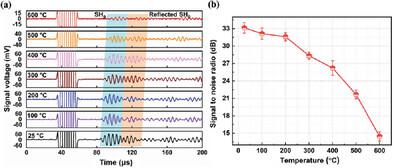当前位置:
X-MOL 学术
›
Adv. Electron. Mater.
›
论文详情
Our official English website, www.x-mol.net, welcomes your feedback! (Note: you will need to create a separate account there.)
Shear Horizontal Guided Wave Sensors Based on CTGS Piezoelectric Crystal for High‐Temperature Structural Health Monitoring
Advanced Electronic Materials ( IF 6.2 ) Pub Date : 2024-03-06 , DOI: 10.1002/aelm.202300851 Guoliang Wang 1 , Shuai Hou 1 , Linfang Xie 1 , Xiangkang Peng 1 , Yanlu Li 1 , Xian Zhao 1 , Shujun Zhang 2 , Xiaoning Jiang 3 , Fapeng Yu 1
Advanced Electronic Materials ( IF 6.2 ) Pub Date : 2024-03-06 , DOI: 10.1002/aelm.202300851 Guoliang Wang 1 , Shuai Hou 1 , Linfang Xie 1 , Xiangkang Peng 1 , Yanlu Li 1 , Xian Zhao 1 , Shujun Zhang 2 , Xiaoning Jiang 3 , Fapeng Yu 1
Affiliation

|
The development of ultrasonic‐guided wave sensors is of great significance for structural health monitoring (SHM). In this work, a shear horizontal (SH) ultrasonic guided wave sensor based on the Ca3 TaGa3 Si2 O14 (CTGS) piezoelectric single crystal is demonstrated. The findings reveal that the CTGS‐based ultrasonic guided wave sensor is proficient in transmitting and receiving pure fundamental SH wave (SH0 wave) along two orthogonal main directions (0° and 90°) over a wide frequency range (100–350 kHz), exhibiting strong response to the SH0 wave. Under the driving voltage of 100 V, the peak‐to‐peak values of the sensor output are 110.8 and 8.0 mV at room temperature and high temperature of 600 °C, respectively. Additionally, the signal‐to‐noise ratio (SNR) of the CTGS‐based SH0 sensor is evaluated to be >18.9 dB even at the elevated temperature of 600 °C. Moreover, the CTGS‐based SH0 sensor showcases its reasonable defect localization ability at temperatures up to 600 °C, demonstrating its great potential for application in the high temperature in‐situ SHM.
中文翻译:

基于 CTGS 压电晶体的剪切水平导波传感器用于高温结构健康监测
超声波导波传感器的发展对于结构健康监测(SHM)具有重要意义。在这项工作中,基于 Ca 的剪切水平 (SH) 超声导波传感器3 塔加3 硅2 氧14 (CTGS)压电单晶被展示。研究结果表明,基于 CTGS 的超声导波传感器能够熟练地发射和接收纯基波 SH 波(SH0 波)沿着两个正交的主方向(0°和90°)在很宽的频率范围(100–350 kHz)上,表现出对SH的强烈响应0 海浪。在100 V驱动电压下,室温和600 ℃高温下传感器输出峰峰值分别为110.8和8.0 mV。此外,基于 CTGS 的 SH 的信噪比 (SNR)0 即使在 600 °C 的高温下,传感器的评估结果也 >18.9 dB。此外,基于 CTGS 的 SH0 传感器在高达 600 °C 的温度下展示了其合理的缺陷定位能力,展示了其在高温原位 SHM 中的巨大应用潜力。
更新日期:2024-03-06
中文翻译:

基于 CTGS 压电晶体的剪切水平导波传感器用于高温结构健康监测
超声波导波传感器的发展对于结构健康监测(SHM)具有重要意义。在这项工作中,基于 Ca 的剪切水平 (SH) 超声导波传感器



























 京公网安备 11010802027423号
京公网安备 11010802027423号